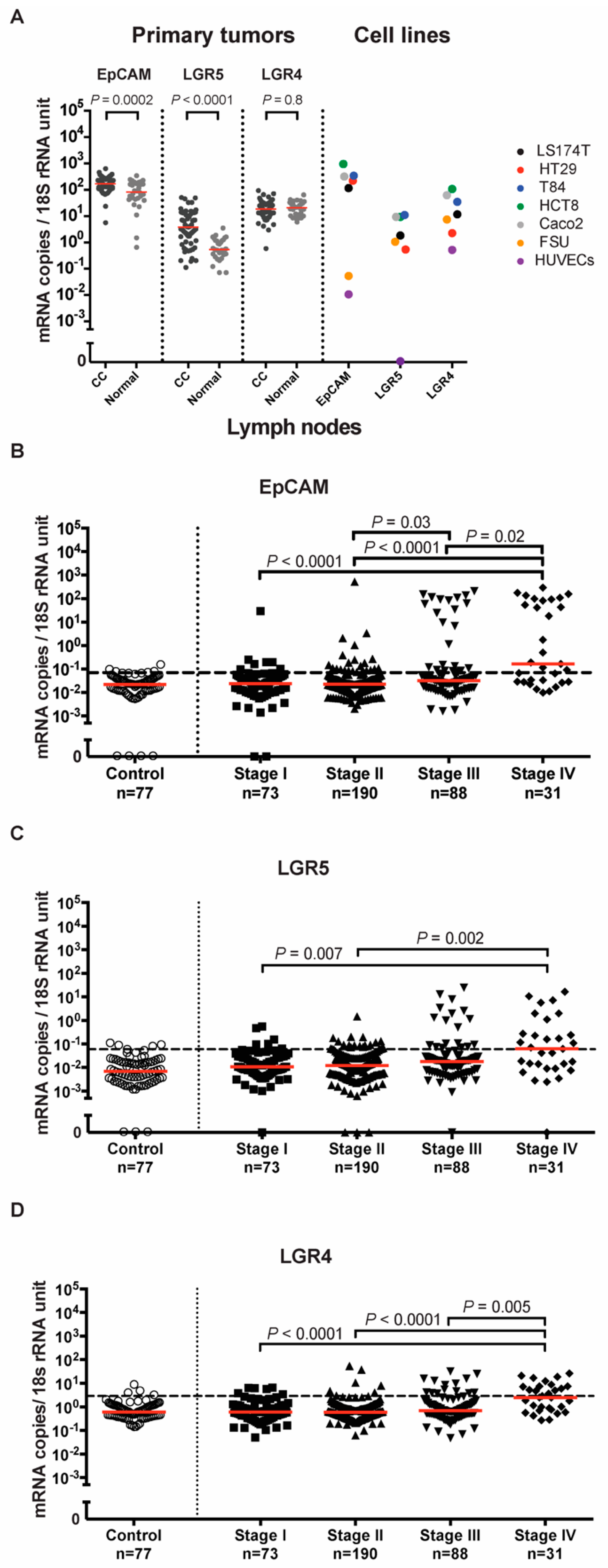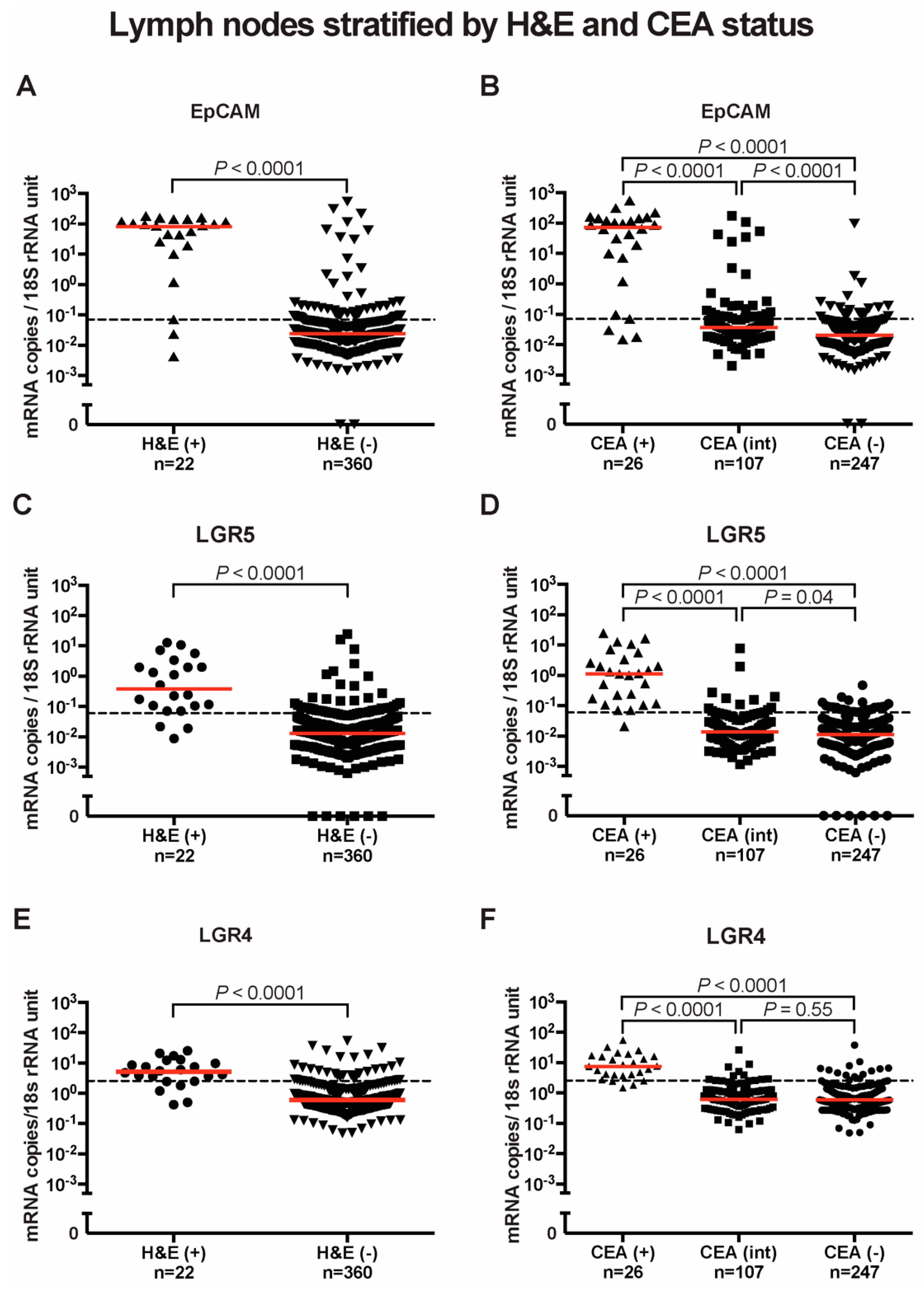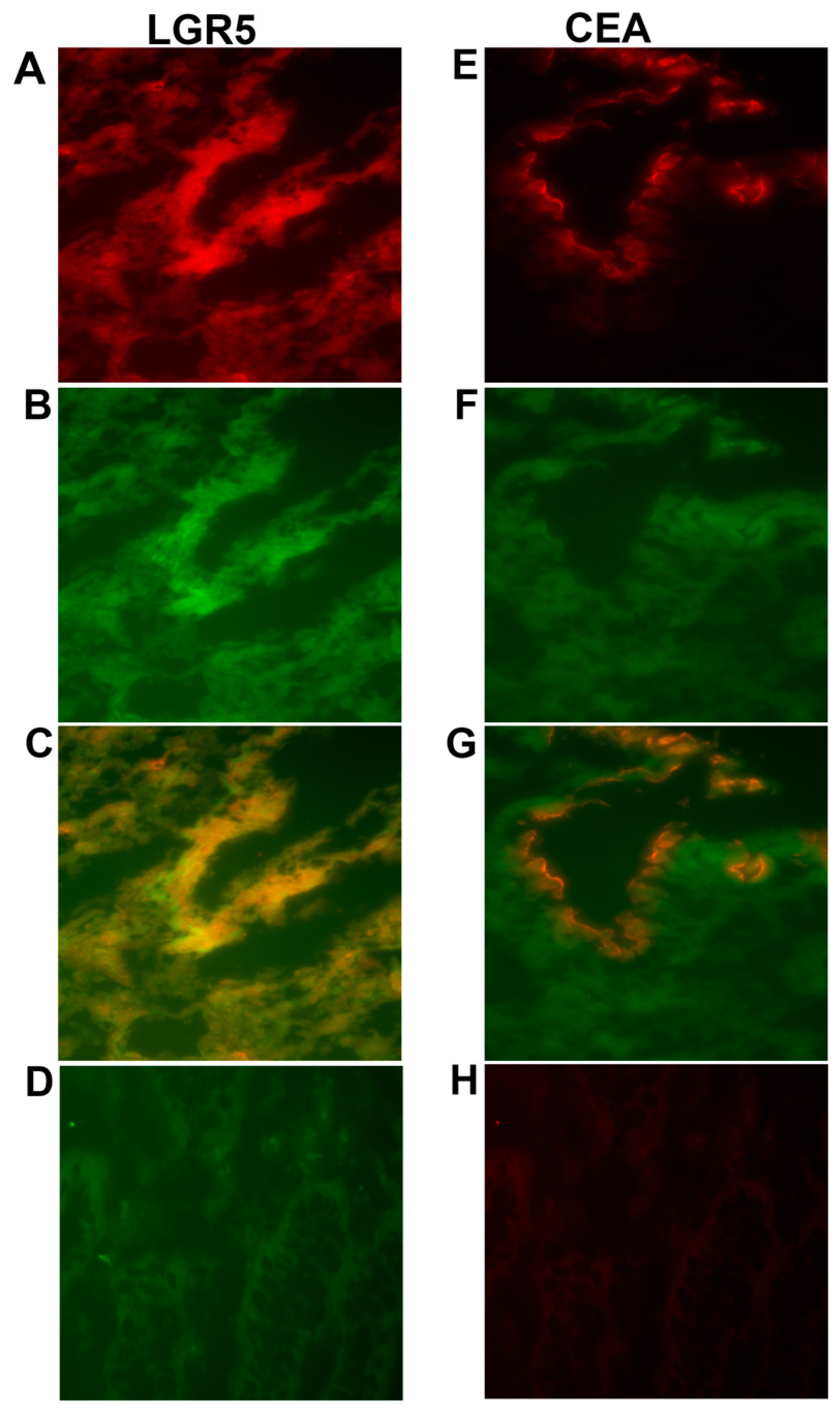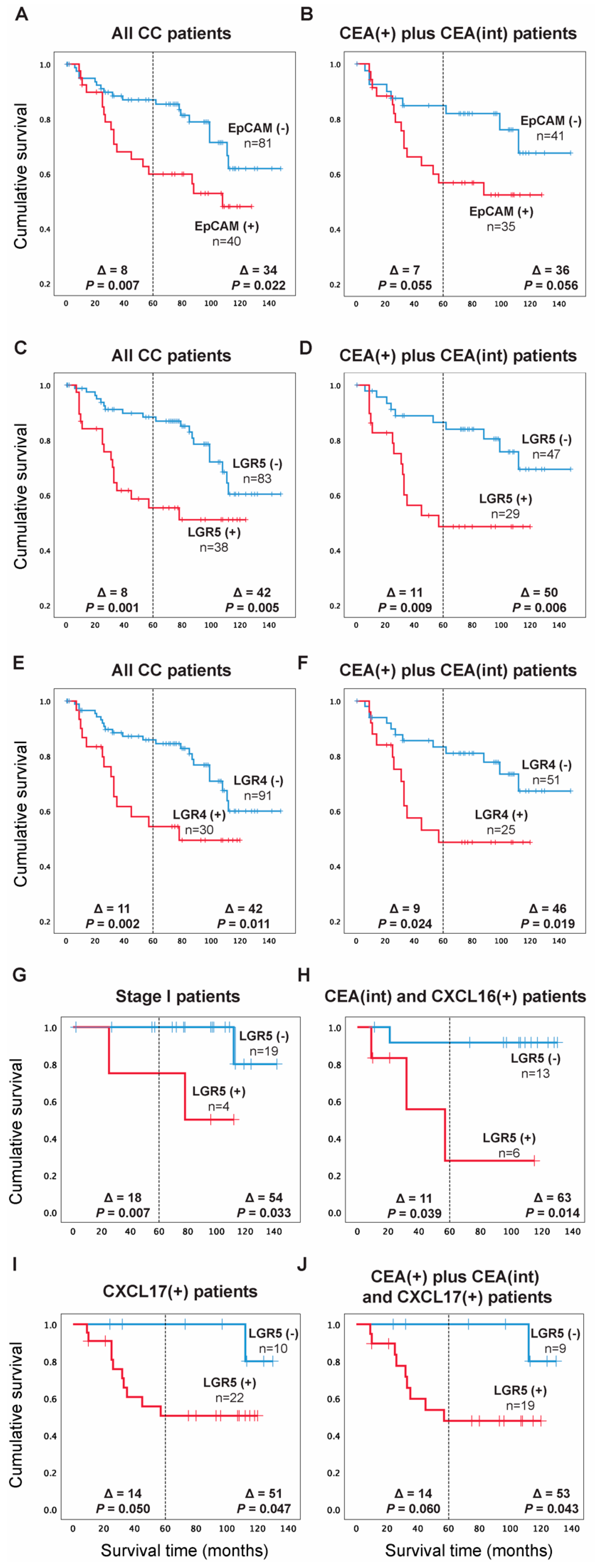Clinical Significance of Stem Cell Biomarkers EpCAM, LGR5 and LGR4 mRNA Levels in Lymph Nodes of Colon Cancer Patients
Abstract
:1. Introduction
2. Results
2.1. Levels of EpCAM, LGR5 and LGR4 mRNA in Primary Colon Cancer Tumors and Colon Cancer Cell Lines
2.2. Levels of EpCAM, LGR5 and LGR4 mRNA in Regional Lymph Nodes of Colon Cancer Patients
2.3. Correlations between mRNA Expression Levels of EpCAM, LGR5, LGR4, CEA, CXCL17, CXCL16 and GPR35 V2/3 in Regional Lymph Nodes of Colon Cancer Patients
2.4. Colocalization of LGR5, CEA and EpCAM Proteins in Primary Colon Cancer Tumors
2.5. Clinical Relevance of EpCAM, LGR5 and LGR4 mRNA Expression Levels in Lymph Nodes for Predicting Colon Cancer Recurrence after Surgery
2.6. Absence of Correlation between the Risk of Recurrence and Survival Time after Surgery with the Levels of EpCAM, LGR5 and LGR4 mRNA Expression in Colon Cancer Primary Tumors
3. Discussion
4. Materials and Methods
4.1. Patients and Tissue Specimens for mRNA Analysis
4.2. Cell Lines
4.3. Real-Time qRT-PCR
4.4. Two-Color Immunofluorescence
4.5. Statistical Analysis
4.6. Ethical Considerations
5. Conclusions
Author Contributions
Funding
Informed Consent Statement
Data Availability Statement
Acknowledgments
Conflicts of Interest
References
- Yadav, A.K.; Desai, N.S. Cancer stem cells: Acquisition, characteristics, therapeutic implications, targeting strategies and future prospects. Stem. Cell Rev. Rep. 2019, 15, 331–355. [Google Scholar] [CrossRef] [PubMed]
- Munro, M.J.; Wickremesekera, S.K.; Peng, L.; Tan, S.T.; Itinteang, T. Cancer stem cells in colorectal cancer: A review. J. Clin. Pathol. 2018, 71, 110–116. [Google Scholar] [CrossRef]
- Hatano, Y.; Fukuda, S.; Hisamatsu, K.; Hirata, A.; Hara, A.; Tomita, H. Multifaceted interpretation of colon cancer stem cells. Int. J. Mol. Sci. 2017, 18, 1446. [Google Scholar] [CrossRef] [PubMed] [Green Version]
- Huang, L.; Yang, Y.; Yang, F.; Liu, S.; Zhu, Z.; Lei, Z.; Guo, J. Functions of EpCAM in physiological processes and diseases (Review). Int. J. Mol. Med. 2018, 42, 1771–1785. [Google Scholar] [CrossRef] [PubMed] [Green Version]
- Van der Gun, B.T.F.; Melchers, L.J.; Ruiters, M.H.J.; de Leij, L.F.M.H.; McLaughlin, P.M.J.; Rots, M.G. EpCAM in carcinogenesis: The good, the bad or the ugly. Carcinogenesis 2010, 31, 1913–1921. [Google Scholar] [CrossRef] [PubMed] [Green Version]
- Dalerba, P.; Dylla, S.J.; Park, I.K.; Liu, R.; Wang, X.; Cho, R.W.; Hoey, T.; Gurney, A.; Huang, E.H.; Simeone, D.M.; et al. Phenotypic characterization of human colorectal cancer stem cells. Proc. Natl. Acad. Sci. USA 2007, 104, 10158–10163. [Google Scholar] [CrossRef] [Green Version]
- Liu, D.; Sun, J.; Zhu, J.; Zhou, H.; Zhang, X.; Zhang, Y. Expression and clinical significance of colorectal cancer stem cell marker EpCAMhigh/CD44+ in colorectal cancer. Oncol. Lett. 2014, 7, 1544–1548. [Google Scholar] [CrossRef] [Green Version]
- Barker, N.; Tan, S.; Clevers, H. Lgr proteins in epithelial stem cell biology. Development 2013, 140, 2484–2494. [Google Scholar] [CrossRef] [PubMed] [Green Version]
- Takahashi, H.; Ishii, H.; Nishida, N.; Takemasa, I.; Mizushima, T.; Ikeda, M.; Yokobori, T.; Mimori, K.; Yamamoto, H.; Sekimoto, M.; et al. Significance of Lgr5+ve cancer stem cells in the colon and rectum. Ann. Surg. Oncol. 2011, 18, 1166–1174. [Google Scholar] [CrossRef]
- Kemper, K.; Prasetyanti, P.R.; De Lau, W.; Rodermond, H.; Clevers, H.; Medema, J.P. Monoclonal antibodies against Lgr5 identify human colorectal cancer stem cells. Stem Cells 2012, 30, 2378–2386. [Google Scholar] [CrossRef]
- Wu, X.-S.; Xi, H.-Q.; Chen, L. Lgr5 is a potential marker of colorectal carcinoma stem cells that correlates with patient survival. World J. Surg. Oncol. 2012, 10, 244. [Google Scholar] [CrossRef] [Green Version]
- Jiang, Y.; Li, W.; He, X.; Zhang, H.; Jiang, F.; Chen, Z. Lgr5 expression is a valuable prognostic factor for colorectal cancer: Evidence from a meta-analysis. BMC Cancer 2015, 15, 948. [Google Scholar] [CrossRef] [PubMed]
- Leng, Z.; Xia, Q.; Chen, J.; Li, Y.; Xu, J.; Zhao, E.; Zheng, H.; Ai, W.; Dong, J. Lgr5+CD44+EpCAM+ strictly defines cancer stem cells in human colorectal cancer. Cell. Physiol. Biochem. 2018, 46, 860–872. [Google Scholar] [CrossRef] [PubMed]
- Gao, Y.; Kitagawa, K.; Hiramatsu, Y.; Kikuchi, H.; Isobe, T.; Shimada, M.; Uchida, C.; Hattori, T.; Oda, T.; Nakayama, K.; et al. Up-regulation of GPR48 induced by down-regulation of p27 Kip1 enhances carcinoma cell invasiveness and metastasis. Cancer Res. 2006, 66, 11623–11654. [Google Scholar] [CrossRef] [Green Version]
- Wu, J.; Xie, N.; Xie, K.; Zeng, J.; Cheng, L.; Lei, Y.; Liu, Y.; Song, L.; Dong, D.; Chen, Y.; et al. GPR48, a poor prognostic factor, promotes tumor metastasis and activates β-catenin/TCF signaling in colorectal cancer. Carcinogenesis 2013, 34, 2861–2869. [Google Scholar] [CrossRef] [PubMed] [Green Version]
- Ohlsson, L.; Hammarström, M.-L.; Lindmark, G.; Hammarström, S.; Sitohy, B. Ectopic expression of the chemokine CXCL17 in colon cancer cells. Br. J. Cancer 2016, 114, 697–703. [Google Scholar] [CrossRef] [PubMed] [Green Version]
- AbdelMageed, M.; Ali, H.; Olsson, L.; Lindmark, G.; Hammarström, M.-L.; Hammarström, S.; Sitohy, B. The chemokine CXCL16 is a new biomarker for lymph node analysis of colon cancer outcome. Int. J. Mol. Sci. 2019, 20, 5793. [Google Scholar] [CrossRef] [Green Version]
- Rashad, Y.; Olsson, L.; Israelsson, A.; Öberg, Å.; Lindmark, G.; Hammarström, M.-L.; Hammarström, S.; Sitohy, B. Lymph node CXCL17 messenger RNA: A new prognostic biomarker for colon cancer. Tumor Biol. 2018, 40, 1010428318799251. [Google Scholar] [CrossRef] [PubMed] [Green Version]
- Ali, H.; Ohlsson, L.; Lindmark, G.; Hammarström, S.; Hammarström, M.-L.; Sitohy, B. The myeloid cell biomarker EMR1 is ectopically expressed in colon cancer. Tumor Biol. 2021, 43, 209–223. [Google Scholar] [CrossRef] [PubMed]
- Ali, H.; AbdelMageed, M.; Olsson, L.; Israelsson, A.; Lindmark, G.; Hammarström, M.L.; Hammarström, S.; Sitohy, B. Utility of G protein-coupled receptor 35 expression for predicting outcome in colon cancer. Tumor Biol. 2019, 41, 1010428319858885. [Google Scholar] [CrossRef] [PubMed] [Green Version]
- Ohlsson, L.; Israelsson, A.; Öberg, Å.; Palmqvist, R.; Stenlund, H.; Hammarström, M.L.; Hammarström, S.; Lindmark, G. Lymph node CEA and MUC2 mRNA as useful predictors of outcome in colorectal cancer. Int. J. Cancer 2012, 130, 1833–1843. [Google Scholar] [CrossRef] [PubMed]
- Bray, F.; Ferlay, J.; Soerjomataram, I. Global cancer statistics 2018: GLOBOCAN estimates of incidence and mortality worldwide for 36 cancers in 185 countries. CA Cancer J. Clin. 2018, 68, 394–424. [Google Scholar] [CrossRef] [Green Version]
- Zarour, L.R.; Anand, S.; Billingsley, K.G.; Bisson, W.H.; Cercek, A.; Clarke, M.F.; Coussens, L.M.; Gast, C.E.; Geltzeiler, C.B.; Hansen, L.; et al. Colorectal cancer liver metastasis: Evolving paradigms and future directions. Cell. Mol. Gastroenterol. Hepatol. 2017, 3, 163–173. [Google Scholar] [CrossRef] [PubMed] [Green Version]
- Hammarström, S. Biomarker mRNAs as prognostic tools for lymph node analysis in colorectal cancer. Biomark. Med. 2019, 13, 801–803. [Google Scholar] [CrossRef] [PubMed] [Green Version]
- Ziskin, J.L.; Dunlap, D.; Yaylaoglu, M.; Fodor, I.K.; Forrest, W.F.; Patel, R.; Ge, N.; Hutchins, G.G.; Pine, J.K.; Quirke, P.; et al. In situ validation of an intestinal stem cell signature in colorectal cancer. Gut 2013, 62, 1012–1023. [Google Scholar] [CrossRef]
- Jang, B.G.; Kim, H.S.; Chang, W.Y.; Bae, J.M.; Kim, W.H.; Kang, G.H. Expression profile of LGR5 and its prognostic significance in colorectal cancer progression. Am. J. Pathol. 2018, 188, 2236–2250. [Google Scholar] [CrossRef] [PubMed] [Green Version]
- Wang, W.; Wan, L.; Wu, S.; Yang, J.; Zhou, Y.; Liu, F.; Wu, Z.; Cheng, Y. Mesenchymal marker and LGR5 expression levels in circulating tumor cells correlate with colorectal cancer prognosis. Cell. Oncol. 2018, 41, 495–504. [Google Scholar] [CrossRef]
- Frängsmyr, L.; Baranov, V.; Hammarström, S. Four carcinoembryonic antigen subfamily members, CEA, NCA, BGP and CGM2, selectively expressed in the normal human colonic epithelium, are integral components of the fuzzy coat. Tumour Biol. 1999, 20, 277–292. [Google Scholar] [CrossRef]
- Baker, A.-M.; Graham, T.A.; Elia, G.; Wright, N.A.; Rodriguez-Justo, M. Characterization of LGR5 stem cells in colorectal adenomas and carcinomas. Sci. Rep. 2015, 5, 8654. [Google Scholar] [CrossRef] [Green Version]
- Fahlgren, A.; Hammarström, S.; Danielsson, A.; Hammarström, M.-L. Increased expression of antimicrobial peptides and lysozyme in colonic epithelial cells of patients with ulcerative colitis. Clin. Exp. Immunol. 2003, 131, 90–101. [Google Scholar] [CrossRef]
- Ohlsson, L.; Hammarström, M.L.; Israelsson, A.; Näslund, L.; Öberg, Å.; Lindmark, G.; Hammarström, S. Biomarker selection for detection of occult tumour cells in lymph nodes of colorectal cancer patients using real-time quantitative RT-PCR. Br. J. Cancer 2006, 95, 218–225. [Google Scholar] [CrossRef] [PubMed]
- Sitohy, B.; Hammarström, S.; Danielsson, Å.; Hammarström, M. Basal lymphoid aggregates in ulcerative colitis colon: A site for regulatory T cell action. Clin. Exp. Immunol. 2008, 151, 326–333. [Google Scholar] [CrossRef] [PubMed]
- Olsson, L.; Lindmark, G.; Hammarström, M.L.; Hammarström, S.; Sitohy, B. Evaluating macrophage migration inhibitory factor 1 expression as a prognostic biomarker in colon cancer. Tumor Biol. 2020, 42, 1010428320924524. [Google Scholar] [CrossRef] [PubMed]




| CEA | CXCL17 | CXCL16 | GPR35 V2/3 | LGR5 | LGR4 | ||||||||
|---|---|---|---|---|---|---|---|---|---|---|---|---|---|
| r | p-Value | r | p-Value | r | p-Value | r | p-Value | r | p-Value | r | p-Value | ||
| EpCAM | All CC LNs | 0.48 | <0.0001 | 0.33 | <0.0001 | 0.63 | <0.0001 | 0.57 | <0.0001 | 0.62 | <0.0001 | 0.67 | <0.0001 |
| TNM Stage I LNs | 0.52 | <0.0001 | 0.48 | <0.0001 | 0.64 | <0.0001 | 0.6 | <0.0001 | 0.57 | <0.0001 | 0.65 | <0.0001 | |
| TNM Stage II LNs | 0.15 | 0.035 | 0.18 | 0.015 | 0.52 | <0.0001 | 0.44 | <0.0001 | 0.5 | <0.0001 | 0.55 | <0.0001 | |
| TNM Stage III LNs | 0.69 | <0.0001 | 0.39 | 0.0002 | 0.64 | <0.0001 | 0.68 | <0.0001 | 0.72 | <0.0001 | 0.75 | <0.0001 | |
| TNM Stage IV LNs | 0.86 | <0.0001 | 0.64 | 0.0001 | 0.76 | <0.0001 | 0.76 | <0.0001 | 0.88 | <0.0001 | 0.75 | <0.0001 | |
| LGR5 | All CC LNs | 0.28 | <0.0001 | 0.31 | <0.0001 | 0.44 | <0.0001 | 0.52 | <0.0001 | 0.68 | <0.0001 | ||
| TNM Stage I LNs | 0.18 | 0.12 | 0.29 | 0.02 | 0.54 | <0.0001 | 0.6 | <0.0001 | 0.8 | <0.0001 | |||
| TNM Stage II LNs | 0.02 | 0.79 | 0.18 | 0.01 | 0.3 | <0.0001 | 0.42 | <0.0001 | 0.53 | <0.0001 | |||
| TNM Stage III LNs | 0.47 | <0.0001 | 0.39 | 0.0002 | 0.46 | <0.0001 | 0.53 | <0.0001 | 0.76 | <0.0001 | |||
| TNM Stage IV LNs | 0.81 | <0.0001 | 0.66 | <0.0001 | 0.61 | 0.0003 | 0.79 | <0.0001 | 0.75 | <0.0001 | |||
| LGR4 | All CC LNs | 0.23 | <0.0001 | 0.24 | <0.0001 | 0.69 | <0.0001 | 0.56 | <0.0001 | ||||
| TNM Stage I LNs | 0.21 | 0.07 | 0.31 | 0.0088 | 0.73 | <0.0001 | 0.67 | <0.0001 | |||||
| TNM Stage II LNs | 0.13 | 0.08 | 0.07 | 0.3255 | 0.61 | <0.0001 | 0.42 | <0.0001 | |||||
| TNM Stage III LNs | 0.45 | <0.0001 | 0.37 | 0.0004 | 0.66 | <0.0001 | 0.63 | <0.0001 | |||||
| TNM Stage IV LNs | 0.58 | 0.0006 | 0.26 | 0.155 | 0.72 | <0.0001 | 0.58 | 0.0006 | |||||
| Patient Group | Category | Number of Patients in Each Group Stratified by the TNM Stage of Colon Cancer | 5 Years Follow-Up after Surgery | 12 Years Follow-Up after Surgery | ||||||||||||
|---|---|---|---|---|---|---|---|---|---|---|---|---|---|---|---|---|
| Disease-Free Survival | Risk for Recurrence | Disease-Free Survival | Risk for Recurrence | |||||||||||||
| Stage I | Stage II | Stage III | Stage IV | Total | Average a | Difference | p-Value | Hazard Ratio | p-Value | Average a | Difference | p-Value | Hazard Ratio | p-Value | ||
| (months) | (months) | (95% CI) b | (months) | (months) | (95% CI) b | |||||||||||
| All CC patients | EpCAM(-) c | 18 | 40 | 21 | 2 | 81 | 54 | 118 | ||||||||
| EpCAM(+) | 5 | 12 | 16 | 7 | 40 | 46 | 8 | 0.007 | 2.5 | 0.010 | 84 | 34 | 0.022 | 2.1 | 0.025 | |
| (1.2–4.9) | (1.1–4.1) | |||||||||||||||
| LGR5(-) d | 19 | 39 | 23 | 2 | 83 | 45 | 120 | |||||||||
| LGR5(+) | 4 | 13 | 14 | 7 | 38 | 37 | 8 | 0.001 | 3.0 | 0.002 | 78 | 42 | 0.005 | 2.5 | 0.007 | |
| (1.5–5.8) | (1.3–4.8) | |||||||||||||||
| LGR4(-) e | 19 | 45 | 25 | 2 | 91 | 54 | 117 | |||||||||
| LGR4(+) | 4 | 7 | 12 | 7 | 30 | 43 | 11 | 0.002 | 2.8 | 0.004 | 75 | 42 | 0.011 | 2.3 | 0.014 | |
| (1.4–5.6) | (1.2–4.6) | |||||||||||||||
| CEA(int) plus CEA(+) f CC patients | EpCAM(-) | 10 | 20 | 9 | 2 | 41 | 53 | 119 | ||||||||
| EpCAM(+) | 3 | 10 | 15 | 7 | 35 | 46 | 7 | 0.055 | 2.2 | 0.062 | 83 | 36 | 0.056 | 2.2 | 0.063 | |
| (0.9–5.0) | (0.9–5.0) | |||||||||||||||
| LGR5(-) | 12 | 21 | 12 | 2 | 47 | 54 | 122 | |||||||||
| LGR5(+) | 1 | 9 | 12 | 7 | 29 | 43 | 11 | 0.009 | 2.8 | 0.012 | 72 | 50 | 0.006 | 3.0 | 0.008 | |
| (1.3–6.4) | (1.3–6.8) | |||||||||||||||
| LGR4(-) | 11 | 25 | 13 | 2 | 51 | 53 | 118 | |||||||||
| LGR4(+) | 2 | 5 | 11 | 7 | 25 | 44 | 9 | 0.024 | 2.4 | 0.029 | 72 | 46 | 0.019 | 2.5 | 0.024 | |
| (1.1–5.4) | (1.1–5.7) | |||||||||||||||
| Patient Group | Category | Number of Patients in Each Group Stratified by the TNM Stage of Colon Cancer | 5 Years Follow-Up after Surgery | 12 Years Follow-Up after Surgery | ||||||||||||
|---|---|---|---|---|---|---|---|---|---|---|---|---|---|---|---|---|
| Disease-Free Survival | Risk for Recurrence | Disease-Free Survival | Risk for Recurrence | |||||||||||||
| Stage I | Stage II | Stage III | Stage IV | Total | Average a | Difference | p-Value | Hazard Ratio | p-Value | Average a | Difference | p-Value | Hazard Ratio | p-Value | ||
| (months) | (months) | (95% CI) b | (months) | (months) | (95% CI) b | |||||||||||
| Stage I CC patients | LGR5(-) d | 19 | 0 | 0 | 0 | 19 | 60 | 136 | ||||||||
| LGR5(+) | 4 | 0 | 0 | 0 | 4 | 42 | 18 | 0.007 | 13.3 | 0.036 | 82 | 54 | 0.033 | 8.7 | 0.077 | |
| (1.2–150.5) | (0.8–96.7) | |||||||||||||||
| CEA(int) and CXCL16(+) CC patients (>7.2) c | LGR5(-) d | 4 | 7 | 2 | 0 | 13 | 57 | 121 | ||||||||
| LGR5(+) | 0 | 3 | 3 | 0 | 6 | 46 | 11 | 0.039 | 7.6 | 0.079 | 58 | 63 | 0.014 | 10.4 | 0.044 | |
| (0.8–73.3) | (1.1–102.9) | |||||||||||||||
| CXCL17(+) CC patients (>0.0012) e | LGR5(-) d | 3 | 3 | 4 | 0 | 10 | 60 | 126 | ||||||||
| LGR5(+) | 3 | 4 | 11 | 4 | 22 | 46 | 14 | 0.050 | 6.1 | 0.087 | 75 | 51 | 0.047 | 6.2 | 0.082 | |
| (0.8–47.4) | (0.8–49.1) | |||||||||||||||
| CEA(int) plus CEA(+) and CXCL17(+) CC patients (>0.0012) f | LGR5(-) d | 3 | 3 | 3 | 0 | 9 | 60 | 126 | ||||||||
| LGR5(+) | 1 | 3 | 11 | 4 | 19 | 46 | 14 | 0.060 | 5.8 | 0.096 | 73 | 53 | 0.043 | 6.8 | 0.075 | |
| (0.7–45.9) | (0.8–55.6) | |||||||||||||||
Publisher’s Note: MDPI stays neutral with regard to jurisdictional claims in published maps and institutional affiliations. |
© 2021 by the authors. Licensee MDPI, Basel, Switzerland. This article is an open access article distributed under the terms and conditions of the Creative Commons Attribution (CC BY) license (https://creativecommons.org/licenses/by/4.0/).
Share and Cite
AbdelMageed, M.; Ismail, H.T.H.; Olsson, L.; Lindmark, G.; Hammarström, M.-L.; Hammarström, S.; Sitohy, B. Clinical Significance of Stem Cell Biomarkers EpCAM, LGR5 and LGR4 mRNA Levels in Lymph Nodes of Colon Cancer Patients. Int. J. Mol. Sci. 2022, 23, 403. https://doi.org/10.3390/ijms23010403
AbdelMageed M, Ismail HTH, Olsson L, Lindmark G, Hammarström M-L, Hammarström S, Sitohy B. Clinical Significance of Stem Cell Biomarkers EpCAM, LGR5 and LGR4 mRNA Levels in Lymph Nodes of Colon Cancer Patients. International Journal of Molecular Sciences. 2022; 23(1):403. https://doi.org/10.3390/ijms23010403
Chicago/Turabian StyleAbdelMageed, Manar, Hager Tarek H. Ismail, Lina Olsson, Gudrun Lindmark, Marie-Louise Hammarström, Sten Hammarström, and Basel Sitohy. 2022. "Clinical Significance of Stem Cell Biomarkers EpCAM, LGR5 and LGR4 mRNA Levels in Lymph Nodes of Colon Cancer Patients" International Journal of Molecular Sciences 23, no. 1: 403. https://doi.org/10.3390/ijms23010403
APA StyleAbdelMageed, M., Ismail, H. T. H., Olsson, L., Lindmark, G., Hammarström, M.-L., Hammarström, S., & Sitohy, B. (2022). Clinical Significance of Stem Cell Biomarkers EpCAM, LGR5 and LGR4 mRNA Levels in Lymph Nodes of Colon Cancer Patients. International Journal of Molecular Sciences, 23(1), 403. https://doi.org/10.3390/ijms23010403






